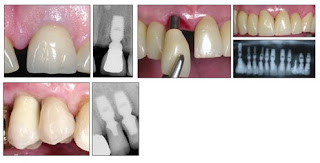BASICS ON DENTAL IMPLANTS

What are implants? Implants are specially made posts that replace the roots of teeth that are missing and are used to support a new crown, fixed bridge or denture. It is made of titanium, a strong and lightweight material which has been shown to be compatible with the body and safe for use. Why do we need to replace missing teeth? Our teeth are an important part of our digestive system as it is needed for chewing food. It plays a role in speech .It is also an important part of our appearance. Finally, it prevents gaps and spaces from appearing between our teeth when a tooth is lost. What are the advantages over conventional replacements? The conventional methods of replacing missing teeth are Bridges or Dentures. Bridges usually involve sticking false teeth onto our existing teeth. This may involve filing down healthy teeth to act as retainers which may compromise the health of these teeth. Bridges can also only be provided when there are sufficient strong remaining teeth. They are...
